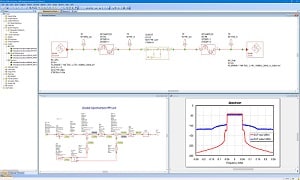The new R&S VSESIM-VSS signal creation and analysis tool speeds up the development process for RF components and systems

Emerging wireless and satellite technologies are offering wider frequency ranges for increasingly demanding requirements of signal simulation in RF system design. Implementation of similar signal creation methods and analysis algorithms for hardware testing enables direct result correlation from the early design to final verification, allowing conclusive and consistent analysis of widely used key performance indicators such as error vector magnitude (EVM).
Corresponding to this, Rohde & Schwarz in collaboration with Cadence Design Systems, Inc. has developed the R&S VSESIM-VSS signal creation and analysis tool, which supports 5G, the latest Wi-Fi evolutions and many more. As a result, developers and design engineers can better address design challenges in the development process related to wireless, automotive, and aerospace and defence.
The R&S VSESIM-VSS signal creation and analysis tool acts as an addition to the Cadence Visual System Simulator (VSS) software for system simulation and modelling of RF components and RF assemblies used in wireless communications and radar design. It expands the simulation capabilities of the Cadence VSS software by adding realistic signals to the workflow.
The R&S VSESIM-VSS builds on the strengths of either company’s solutions by combining signal generation, design simulation and signal analysis. It leverages the signal generation capabilities of the R&S WinIQSIM2 simulation software and the signal analysis capabilities of the R&S VSE vector signal explorer software. Plug-ins for Cadence electronic design automation (EDA) tools have also been added.
The data sink plug-in from Rohde & Schwarz provides access to the signal at any point in the design process. The signal can be transferred to a vector signal generator and applied to available hardware, enabling system-level analysis of hybrid hardware/simulated implementations.
The R&S VSESIM-VSS supports direct digital predistortion (DPD) techniques to verify the linearisation effects present during the simulation of the power amplifier.
An added benefit of combining the solutions is increased compatibility between Rohde & Schwarz and Cadence tools. Signal generation and analysis provided by the Rohde & Schwarz solutions can also be used in other connected Cadence products such as the Cadence Microwave Office circuit design software or the Cadence Virtuoso RF Solution for radio-frequency integrated circuits (RFIC) and RF modules.
“Connecting EDA design simulation and test and measurement help our customers achieve first-pass design success and shorter times to market. Using realistic signals, deriving common figures of merit such as EVM and understanding linearisation capabilities even before tape-out means a competitive advantage for our customers. We look forward to bringing the results of our cooperation with Cadence to the market,” said Christina Gessner, Vice President Spectrum & Network Analyzers, EMC and Antenna Test at Rohde & Schwarz.
Vinod Kariat, corporate vice president of R&D in the Custom IC & PCB Group at Cadence adds, “Customers developing RF frontend communication ICs and systems require access to the latest communications standards. The joint solution from our companies enables our mutual customers to accurately analyse standard compliant signals throughout the design phase, including final test validation.”
R&S VSESIM-VSS is now available from Rohde & Schwarz.







